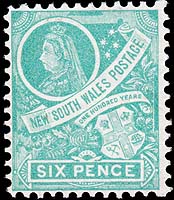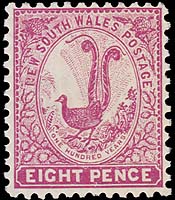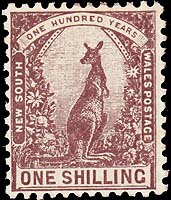The 1893 proposal and the stamped transmission forms.
- Australia 1901-1988
- New South Wales
- Overview of NSW
- Telegraph lines
- Telegraph Offices
- Date stamps
- Forms
- Envelopes
- Instructional annotation
- Collect
- Delayed
- Free
- Immediate Urgent
- Reply paid
- Rates
- Stamps
- 1871 Telegraph stamps
- 1885 proposal
- 1893 proposal
- Queensland
- South Australia
- Tasmania
- Victoria
- Western Australia
- International
- Special aspects
New South Wales had tried to introduce the system of pre-paying telegram charges on two previous occasions :
- 1871 with the specially designed Telegraph stamps;
- 1885 - in the poorly planned attempt to use postage stamps -and later overprinted duty stamps;
In the early 1890s, discussion began again about a possible strategy to pre-pay the costs of sending a telegram involving printing of stamp images on the transmission forms. The lead for such forms was provided by the embossed forms issued by Victoria (VC--TO-6) in 1873 and by Western Australia (WC-TO-2) in 1879 and by the printed image issued by Queensland in 1882.
In part, the suggestions also stemmed from a Commission of Inquiry into the efficiency of the Telegraph Office - held about the time of E. C. Cracknell's death in January 1893.
The 1893 initiative is described here as follows:
- the general reaction reflected in the newspapers before the announcement;
- the official announcement;
- the postage stamps available for prepaying telegram charges in 1893.
The forms with the 6d. image (NC-TO-8) and with the 1/- image (NC-TO-9) can be accessed elsewhere.
General reaction to the proposal.
One of the many newspaper editorials - Goulburn Herald of 1 March 1893 - is as follows:
PREPAYMENT OF TELEGRAMS BY STAMPS.
"Included in the recommendations of the public service inquiry commission into the Electric Telegraph Department was a representation that the system of checking the telegraph business was elaborate and costly and the commission went on to say that they were satisfied that a large saving could be secured by adopting the system of prepayment of telegrams by stamps, and by substituting an occasional check, as is now done in some of the other colonies and in Europe, for the continuous check now in use.
The Deputy Postmaster-General (Mr. Lambton) has carefully gone into the question in connection with the amalgamation just being effected in the various departments under the ministerial control of the Postmaster-General, and he is of the opinion that, while at first there will be some complaint of the extra trouble imposed on the senders of messages by being required to affix stamps, on the other hand the advantages to be derived and the economy secured will more than compensate for the objections. The benefits from a financial point of view will be the lessening of the clerical labour in connection with accounts, it being estimated that the staff can be reduced by at least five in the head office alone, whilst in the country and suburban offices the work will be considerably lessened and will ultimately lead to the employment of fewer hands, especially in the larger offices. The saving consists of the doing away with the elaborate system of checking messages between country and head offices, which is necessary under existing arrangements.
It is proposed for the convenience of business people, who largely send telegrams, to have the forms made up in books, each form being impressed with a stamp, as in the case of cheque-books, whilst the general public will be able to send their telegrams as they do letters, the convenience to all being that it will not be necessary to entrust messengers and others with the nature of the contents of the messages or with the money to pay for them. Telegrams, after being stamped, can either be enclosed in sealed envelopes and be posted in any receiver or delivered at the nearest office. For the present the impressed forms to be issued will bear only 6d. and 1/- stamps respectively for suburban and country messages. It has been ascertained that about 80 per cent of all messages dispatched do not exceed ten words, and therefore pass at the initial rate. Where the ten words are exceeded, ordinary stamps representing the excess will be permitted to be placed alongside the impressed stamps. It will not be compulsory to use impressed stamps.
The Postmaster-General (Mr. Kidd) has approved of the introduction of the system as proposed, and of the preparation of detailed rules for the guidance of the public and the officials concerned, after the concurrence of the Treasury Department has been obtained.
In one of the other colonies, where the stamp system is in force, it in considered that some unnecessary circumlocution takes place in regard to messages being taken to one counter, where the number of words is reckoned and the amount payable marked. They are then taken to another counter and stamps purchased, after which they are lodged at the first counter. Mr. Lambton sees no reason for these three transactions. An inquiry office having been opened in the receiving-room of the telegraph department, the number of words could be counted and all inquiries made at this office (as is done at the post-office stamp sales and inquiry office), and the messages can then be lodged at the receiving counter as a letter is lodged at the posting- boxes, thus making two counter-transactions instead of three.
In regard to any persons spoiling one of the forms in writing out his message, by erasure or otherwise, he will be allowed, if desired, to re-write the message on an ordinary piece of paper, and paste or otherwise attach the rewritten one to the original message bearing the impressed stamp.
Some years ago a system of prepayment of telegrams by means of stamps was introduced in Sydney, but was soon afterwards withdrawn. The non-success of this experiment was owing to the imperfect system under which it was introduced, and it is not considered that any difficulty will arise in making the new proposal a success".
The public were immediately sceptical:
STAMP PAID TELEGRAMS
Bathurst Free Press and Mining Journal
28 February 1893.
"The Postmaster-General is evidently determined to give the system of pre-payment of telegrams by stamps another trial, although the experience gained when a similar attempt was made some years ago was not at all favorable to its continuance .... The contention of the authorities is that under this system, a saving to the Department will be made inasmuch as only an occasional check will be required under that system instead of the continuous check now in force. And the clerical labor thus having been lessened, a less number of hands will be required to perform office work.
We very much question, however, whether the Department will be able to effect much saving by the change proposed and certainly the public, who have occasion to do business by wire,will be greatly inconvenienced. The system of cash payments, as far as the senders of messages are concerned, cannot be improved upon by the substitution of stamps for money and we cannot see how the checking process will be made any simpler or more efficacious than under the present system. The Department will find that checking telegrams prepaid by stamps affixed will be quite as difficult and will involve the the employment of quite as many officers as checking of messages for which the cash is paid; and the public will look upon the change as another of the "fads" in which superior officers in Government departments indulge for the purpose of shining as administrators. The present is no time to indulge in little experiments of this sort and, if the Postmaster-General is wise, he will abandon this last attempted change which can only result in annoyance to the public and disappointment to the Department of which he is the head".
The 6d denomination covered the cost of a city or suburban ordinary rate for 10 words or less while the 1/-denomination paid the cost of an inland telegram of 10 words or less.
The scheme was adopted and the official announcement, repeated in the 1893 Report to Parliament, was as follows:
Postal and Electric Telegraph Department, General Post Office
Sydney 14 September 1893.
His Excellency the Governor, with the advice of Executive Council, having been pleased to approve of the introduction of the system of prepayment of telegrams by postage stamps, it is hereby notified for public information that, on and after the 1st October next, the charges on telegrams lodged for transmission within New South Wales or to any of other of the Australian Colonies (New Zealand excepted) must be prepaid by means of postage stamps.
The public will be required to affix the stamps to the message forms, just as they are required to affix stamps to letters.
Stamps may be obtained at any Telegraph Office in the Colony and the Officers to whom the messages are handed for transmission will cancel the stamps thereon.
Messages to which the proper amount in unobliterated postage stamps has been affixed may be posted in any Post Office or letter-receiver, enclosed in a cover addressed to the nearest Telegraph Office from which the messages will be duly transmitted to destination by wire.
"Collect" messages (i.e. messages on which charges are to be paid by the addressee) will on no account be accepted unless they are answers to "reply-paid" messages. In cases of emergency or distress, however, persons may (at the discretion of the Station-master) send messages to be paid for by the receiver.
The sender of a message to which a reply is requested will be required to lodge a deposit, which in the event of no reply being received, will, on application to the Station-master, be refunded.
John Kidd
Ordinary adhesive postage stamps were used rather than print special stamps - with the slight exception of the 10/- Stamp Duty overprinted POSTAGE. That procedure remained in place through Federation and up to the 1970s when cash register receipts were simply easier to organise.
The stamps available at that time for prepaying telegraph costs were some denominations from each of the Centennial set and the Queen Victoria issues. Although lower denominations could be used, the telegraph rates were such as to generally require denominations of 6d and then from 1/- upwards. There were six stamps available in this category:
 6d turquoise Queen Victoria. |
 6d orange Queen Victoria. |
 8d magenta Lyre Bird. |
 1/- brown Kangaroo. |
 5/- deep purple Map of Australia. Millennium Auctions Sale 54 November 2012, Lot 789. |
 20/- light cobalt Carrington. |
The new telegraph transmission form (NC-TO-7C) released in 1898 again contained a space in the top right corner "FOR POSTAGE STAMPS". That form was released four years after the transmission forms with the printed stamp images (NC-TO-8 and NC-TO-9).